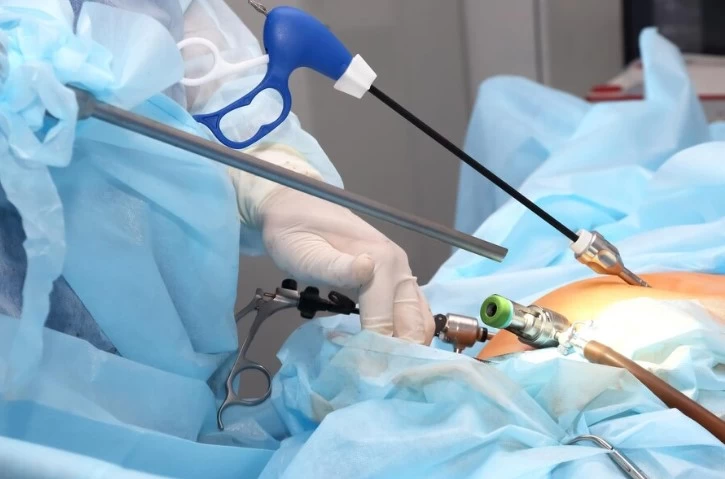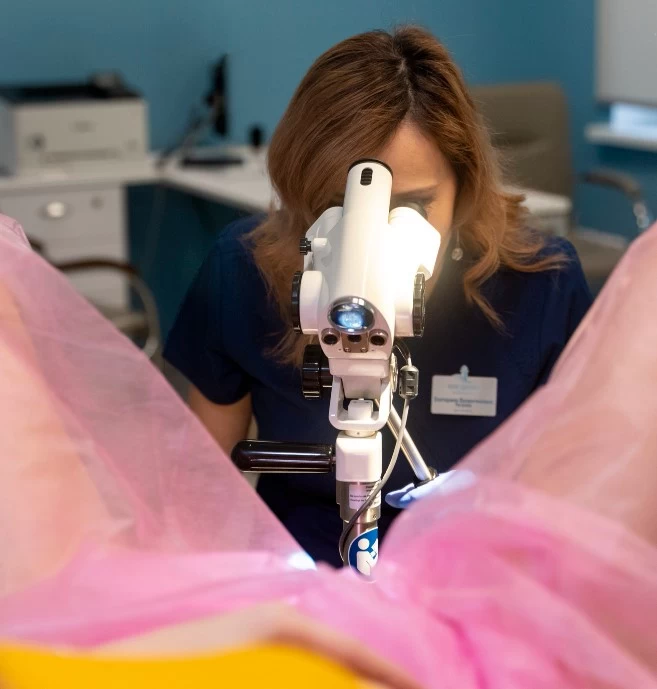
Laparoscopic Hysterectomy: Reasons, Process, and Treatment Methods
- Laparoscopic Hysterectomy: Reasons, Process, and Treatment Methods
- Reasons for Laparoscopic Hysterectomy
- Advantages of Laparoscopic Hysterectomy
- Preoperative Preparation
- The Process of Laparoscopic Hysterectomy
- Postoperative Period
- Treatment Methods and Alternatives
- Conclusion
Laparoscopic hysterectomy, commonly referred to as a minimally invasive surgical method in gynecology, is one of the procedures we frequently perform in the treatment of various gynecological conditions. This surgery is less traumatic compared to traditional open surgery and offers several advantages for patients, such as shorter recovery time, less pain, and a faster return to normal life.
Reasons for Laparoscopic Hysterectomy
There are various gynecological reasons for recommending a hysterectomy to a woman. These include:
- Fibroids: Uterine fibroids, which are benign tumors of the uterus, can cause pain, irregular menstruation, and pressure. Large fibroids or those that do not respond to other treatment methods may necessitate the removal of the uterus.
- Endometriosis: Endometriosis is a condition where the lining of the uterus (endometrium) grows outside the uterus, leading to severe pain, menstrual irregularities, and infertility. When other treatment methods fail, hysterectomy may be an option.
- Uterine Prolapse: Weakening of the pelvic floor muscles can cause the uterus to descend into the vagina, leading to issues like urinary incontinence and discomfort. In advanced cases of prolapse, removal of the uterus may be required.
- Cancer: In cases of uterine, ovarian, or cervical cancer, hysterectomy can be performed to prevent the spread of cancer and to treat it effectively.
- Severe Menstrual Bleeding: Excessive menstrual bleeding that does not respond to hormonal treatments can significantly reduce a woman’s quality of life. In such cases, removal of the uterus may be recommended.
- Chronic Pelvic Pain: Hysterectomy can also be considered for chronic pelvic pain that is not linked to other causes but severely impacts a woman’s quality of life.
Advantages of Laparoscopic Hysterectomy
Laparoscopic surgery offers numerous advantages over open surgery. These include:
- Small Incisions: Unlike open surgery, which requires a large incision, laparoscopic surgery involves making several small incisions in the abdomen to insert specialized surgical instruments. This results in smaller scars and a shorter recovery time.
- Less Pain: Patients experience less pain after laparoscopic surgery, and their need for pain medication is lower.
- Shorter Hospital Stay: Patients are typically discharged from the hospital within 1-2 days following laparoscopic hysterectomy, whereas open surgery usually requires a hospital stay of 3-5 days.
- Faster Recovery: While recovery from open surgery may take 4-6 weeks, recovery from laparoscopic hysterectomy generally takes 2-3 weeks.

Preoperative Preparation
Before surgery, a thorough evaluation is necessary. The patient's medical history, current health conditions, medications, and overall health status are taken into consideration. The preoperative steps usually include:
- Blood Tests: Blood count, clotting time, and other biochemical tests are performed.
- Imaging Tests: Imaging tests like ultrasound or MRI may be done to assess the size, structure, and relationship of the uterus to nearby organs.
- Anesthesia Assessment: Since the surgery is performed under general anesthesia, a consultation with an anesthesiologist is required to evaluate suitability for anesthesia.
- Preoperative Diet: Patients are instructed to avoid solid food the night before surgery and to consume only liquids on the morning of the surgery.
The Process of Laparoscopic Hysterectomy
The surgery is performed under general anesthesia, and typically follows these steps:
- Incisions: A small incision is made near the belly button to insert a laparoscope, a thin, lighted camera. This camera allows us to view the internal organs in detail on a screen. Additional small incisions are made in the lower abdomen to insert surgical instruments.
- Removing the Uterus: The ligaments and blood vessels surrounding the uterus are cut using special surgical tools, and the uterus is freed. The uterus may then be removed in small pieces (morcellation) through the small incisions or extracted vaginally.
- Controlling Bleeding: To minimize bleeding, the blood vessels are carefully tied off and controlled during the surgery.
- Closing the Incisions: Once the surgery is complete, the small incisions are closed with cosmetic stitches, and the procedure is concluded.
Postoperative Period
After the surgery, patients are usually observed in the hospital for 1-2 days. During this time, pain management is provided, and patients are encouraged to move. The recovery process varies from patient to patient, but in general, recovery following laparoscopic surgery is as follows:
- Pain: Mild pain may be present for the first few days after surgery, but this can usually be managed with painkillers.
- Mobility: Patients are encouraged to walk early after surgery, as prolonged bed rest can increase the risk of blood clots.
- Recovery Time: Full recovery usually takes 2-3 weeks. During this period, patients should avoid lifting heavy objects.
Treatment Methods and Alternatives
Before recommending hysterectomy to any patient, other treatment options are considered. In cases of fibroids or endometriosis, medication, hormone therapy, or other minimally invasive surgical methods may be viable alternatives. However, when these methods are insufficient, or in cases of cancer, hysterectomy is the most appropriate treatment.
Conclusion
Laparoscopic hysterectomy is one of the most effective and comfortable methods modern surgery offers. This procedure is performed to improve women’s quality of life and ensure they can lead healthy lives. While recovery times may vary from patient to patient, overall recovery is quick and generally without complications. After a hysterectomy, patients will no longer have menstrual periods and will lose their ability to conceive, so all alternatives should be carefully evaluated before making a decision.
One of our most important responsibilities is to provide detailed information before and after surgery, offer psychological support, and ensure a smooth recovery process for our patients.

Assoc. Prof. Dr. Pervin Karlı
Obstetrics and Gynecology Specialist





